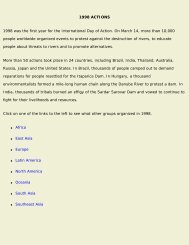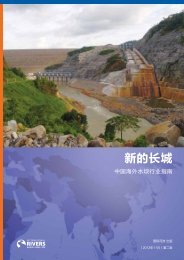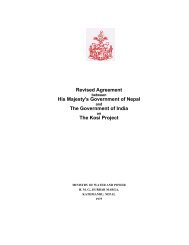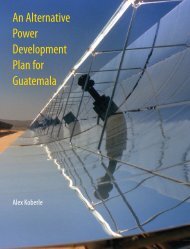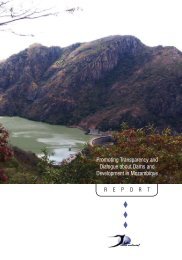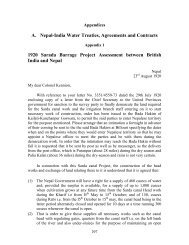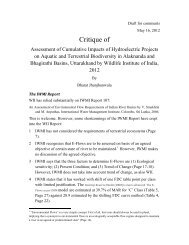Proposed Power Development Plan (PDP) 2012 - Palang Thai
Proposed Power Development Plan (PDP) 2012 - Palang Thai
Proposed Power Development Plan (PDP) 2012 - Palang Thai
- No tags were found...
Create successful ePaper yourself
Turn your PDF publications into a flip-book with our unique Google optimized e-Paper software.
<strong>Proposed</strong> <strong>Power</strong> <strong>Development</strong> <strong>Plan</strong> (<strong>PDP</strong>) <strong>2012</strong>and a Framework for Improving Accountability and Performance of <strong>Power</strong> Sector <strong>Plan</strong>ning<strong>Power</strong> <strong>Development</strong> <strong>Plan</strong>: procuring supply to meet demandIn conventional practice, with the load forecast in place, EGAT develops a draft <strong>PDP</strong> that is then reviewed bygovernment committees and approved by the cabinet. In developing the <strong>PDP</strong> 2010, EGAT uses commercial softwarethat includes an algorithm that selects among the candidate supply options listed in the bullet points below. Theseoptions are generally new plants in “green-field” sites (sites that have never had a power plant before) or newplants added to existing “brown-field” sites (sites that already have an existing power plant) that have the abilityto expand:• natural gas combined cycle gas turbine (CCGT), 800 MW per plant• nuclear, 1000 MW per plant• coal, 800 MW per plantIn EGAT’s <strong>PDP</strong> these options are augmented by a very limited amount (0.3% of total GWh) of demand sidemanagement (DSM) and some renewable energy (VSPP and SPPs). The plan also includes a disquieting amount ofimports of hydropower and polluting lignite-fired electricity from neighboring countries. Currently plannedimports of electricity from hydropower and lignite power plants in Laos and Cambodia are not subject to <strong>Thai</strong>environmental regulations and public review, but this does not make the impacts any less real. The silence is morereflective of the restricted ability to protest, or limited awareness by communities that will be affected in thefuture. In the case of coal and some hydropower projects, downstream and downwind impacts will even hurt<strong>Thai</strong>land. But because the project is across an international border (though some investors of these projects maybe <strong>Thai</strong> companies or even EGAT’s subsidiaries), <strong>Thai</strong>s’ opportunities for redress are also limited.In the official <strong>PDP</strong>, electricity import projects receive special treatment. They are treated as “policy inputs” and arenot required to compete with other options. The rest of the <strong>PDP</strong> is then built around these assumed bilateral coaland hydropower import projects, selecting coal, gas or nuclear based on the computer program’s selection criteria.These resource options, we believe, reflect an overly restrictive vision of options for the power sector. Below wepresent a discussion of an expanded field of resource options.Resource optionsTraditionally EGAT’s approach has been to respond to projected increases in demand by planning new large-scalepower plants. But this is not the only way of doing things. International best practice is to consider electricityplanning as holistically as possible, as a problem in delivering energy services, not just delivering kilowatt hours ofenergy. Thus, it makes more sense to consider all least cost measures that will provide the same service, comfortand convenience, even if this means not having to sell more electricity. Taking this Integrated Resource <strong>Plan</strong>ning(IRP) frame substantially broadens options (Swisher, 1997; D’Sa, 2005). The broader menu of choices includeinvestments to acquire energy savings, clean renewable energy generation, cogeneration, as well as plant lifeextension, repowering, and brownfield siting of conventional power plants.Energy efficiency and demand-side managementSaving electricity is almost always cheaper than building new power plants and fueling them for decades. EGAT’sown analysis has shown that its demand side management (DSM) 5 programs deliver saved electricity at less thanhalf the cost of building new power plants (Foran, Pont et al. 2009). Kilowatt-hour (kWh) savings acquired throughinvestment in energy efficiency are not only the cheapest way to meet growing demand compared to othergeneration options; they also help save transmission, distribution and conversion losses and wastes along thesupply chain of electricity from fuel to generation to delivery to customers. They also save or defer investments in5Demand Side Management (DSM) is another name for energy effi ciency – referring to addressing electricity demand at the ‘demandside’ by lowering or shifting load, not at the ‘supply side’ by building power plants.14




